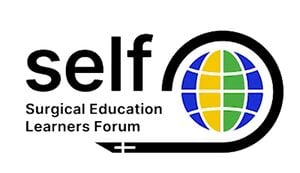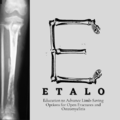This program is run by the Foothill College EMS Programs. The materials in this course encompass the psychomotor skills necessary to meet EMT certification standards in the state of California and gaining eligibility to sit the NREMT cognitive exam. They are listed in the order in which they should be learned, with a focus on mastering the fundamentals first, as some later skills build upon techniques learned in earlier skills. Typically the course is taught in a 2 quarter sequence.
ALL-SAFE is an international collaboration of surgeons and scientists to teach surgeons in the low-resource setting to perform laparoscopic surgery without special training equipment and a physical teacher.
This module allows medical officers and surgeons who are not orthopedic specialists to become confident and competent in irrigation and debridement, powered and manual drilling, positioning and correctly inserting Schanz screws, and constructing the rod-to-rod modular frame as part of external fixation procedures for open tibial shaft fractures performed in regions without specialist coverage.
Z-plasty is a random-pattern local flap and an essential tool within the reconstructive surgery repertoire. It is primarily used to (1) lengthen contracted scars resulting from burns and trauma, (2) reorient conspicuous scars for better alignment with natural skin folds, and (3) deepen contracted web spaces.
This module allows medical officers, junior orthopedic surgery residents, and surgeons who are not orthopedic specialists to become confident and competent in irrigation and debridement, powered and manual drilling, positioning and correctly inserting Schanz screws, and constructing the uniplanar external fixator frame as part of external fixation procedures for open tibial shaft fractures performed in regions without specialist coverage. To maximize patient safety, this module teaches learners to use a powered drill to insert self-drilling Schanz screws through the near cortex and then manually advance Schanz screws into the far cortex to avoid plunging.
This module allows medical officers and surgeons who are not orthopedic specialists to become confident and competent in irrigation and debridement, powered and manual drilling, positioning and correctly inserting Schanz screws, and constructing the rod-to-rod modular frame as part of external fixation procedures for open humeral shaft fractures performed in regions without specialist coverage. To maximize patient safety, this module teaches learners to use a powered drill to insert self-drilling Schanz screws through the near cortex and then manually advance Schanz screws into the far cortex to avoid plunging.
CrashSavers Trauma is focused on teaching firefighter first responders in Guatemala how to stop bleeding in injured individuals and prevent mortality from hemorrhagic shock. Low- and middle-income countries lack an organized prehospital infrastructure. This, coupled with the absence of formal medical training for prehospital providers, creates suboptimal conditions for providers and patients. Improvement in provider competence and thus, patient safety, are at a standstill until formalized training in hemorrhage control techniques is provided.
This module allows traditional bone setters, pre-hospital providers, clinical officers, nurses, nurse practitioners, and medical officers to become confident and competent in performing point-of-care ultrasound diagnostic imaging to rule out the presence of a pediatric distal forearm fracture and distinguish between buckle (torus) fractures and cortical break fractures to make appropriate referrals as part of the management of closed pediatric (< 16 years of age) distal forearm fractures in regions without access to X-ray imaging and orthopedic specialist coverage.
Welcome to the AMPATH Surgical App (ASAP) Curriculum
The Sexual and Reproductive Health and Rights (STARS) - Cervical Cancer Screening and Treatment module allows nurses, midwives, clinical officers, and medical officers to become confident and competent in performing visual inspection with acetic acid (VIA), and thermal ablation of cervical pre-cancer lesions as part of cervical cancer screening and treatment procedures provided in primary health care facilities and mobile units in resource-constrained settings.
ETALO in the Ugandan language of Luganda means "bone infection". For us, ETALO is also an acronym that stands for Education To Advance Limb-Saving Options for Open Fractures and Osteomyelitis.
OpenSurgiSim is a surgical training system developed by AlgoSurg and Center for Limb Lengthening & Reconstruction for orthopaedic surgeons to learn all the steps of accurate correction of bone deformities. AlgoSurg Inc., USA has been developing many innovative technologies for variety of bone surgeries, specially for lower-limb. The CLLR, Mangal Anand Hospital, Mumbai, India is renowned for its advanced approach to limb lengthening and reconstructive/deformity surgery and research. Together both the organisations developed and clinically tested OpenSurgiSim to bring the best practices of deformity correction surgeries in a form of training module.
Our surgical training modules aim to enable novice surgeons to become confident and competent in dissecting the Calot's triangle, as part of the Laparoscopic Cholecystectomy surgery performed in a simulated environment using Virtual and Augmented Reality (AR/VR).
This STARS (Sexual and Reproductive Health and Rights) - Intrauterine Device (IUD) Insertion module allows nurses, midwives and clinical officers to become confident and competent in maintaining aseptic technique in sounding the uterus, loading the IUD in the sterile package, setting the gauge to the sounded depth, and gently inserting and deploying the IUD as part of copper and hormonal IUD insertion procedures for long-acting reversible contraception services performed in low to middle income countries.
Goal statement: Our goal is to provide a cost efficient simulation-training module, which enables you (the surgical trainee) an opportunity to learn, assess your progress, and gain surgical psychomotor skills without the presence of an instructor.
This training module allows medical officers (non-specialist physicians) and general surgeons to become confident and competent in the gentle handling of delicate infant tissues as part of neonatal colostomy procedures performed in low to middle income countries (LMICs).
This module allows surgical practitioners to become more confident and competent in Orthoplastic reconstruction by removing contaminated debris and all devitalized tissue, stabilizing the skeleton and covering the soft tissue defect. This should reduce the bacterial burden and available substrate for microbial colonization, resulting in fewer deep surgical site infections. This will lead to improved patient outcomes in Sub-Saharan Africa (SSA). The situation in Rwanda is of grave concern as only two trained plastic surgeons and three plastic surgeon residents treat 13.28 million people. Currently, Rwanda has a surgical workforce of fewer than 2 surgeons, anesthesiologists, and obstetricians (SAOs) per 100,000 population, and investing in the training and education of the surgical workforce is the best way to increase the number of surgical interventions in Rwanda.
This course has a critical difference from other Trauma Management courses. The target of instruction is the Team.
This module allows surgical practitioners to become more confident and competent in V-Y Advancement Flap by utilizing basic geometry to either recruit tissue or redistribute it to achieve some form of reconstruction – primarily for releasing scars and closing defects in Sub-Saharan Africa (SSA). The situation in Rwanda is of grave concern as only two trained plastic surgeons and three plastic surgeon residents treat 13.28 million people.
The GlobalSurgBox, the Universal Surgical Simulator that fits in a toolbox, is a surgical simulator that fits in a 12.5-inch toolbox, is capable of teaching trainees valuable surgical skills such as: knot tying, basic and advanced suturing, bowel and vascular anastomoses, aortic valve replacement, and numerous other new and emerging possibilities.


















